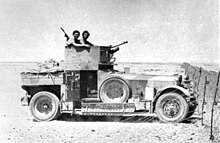Lawrence of Arabia used a squadron in his operations against the Turkish forces. He called the unit of nine armoured Rolls-Royces "more valuable than rubies" in helping win his Revolt in the Desert. This impression would last with him the rest of his life; when asked by a journalist what he thought would be the thing he would most value he said "I should like my own Rolls-Royce car with enough tyres and petrol to last me all my life".
In the Irish Civil War (1922–1923), 13 Rolls-Royce armoured cars were given to the Irish Free State government by the British government to fight the Irish Republican Army. They were a major advantage to the Free State in street fighting and in protecting convoys against guerrilla attacks and played a vital role part in the retaking of Cork and Waterford. Incredibly, despite continued maintenance problems and poor reaction to Irish weather, they continued in service until 1944, being withdrawn once new tyres became unobtainable. Twelve of the Irish Army examples were stripped and sold in 1954.
At the outbreak of World War II, 76 vehicles were in service. They were used in operations in the Western Desert, in Iraq, and in Syria. By the end of 1941, they were withdrawn from the frontline service as modern armoured car designs became available. Some Indian Pattern cars saw use in the Indian subcontinent and Burma.
From Wikipedia, the free encyclopedia



















Keine Kommentare:
Kommentar veröffentlichen